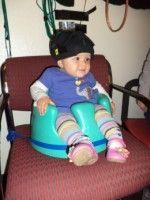For more than 10 years, researchers at Texas A&M have been trying to answer a not-so-simple question of cognition: what is the world like through the eyes of an infant?
Teresa Wilcox is the director of the Infant Cognition Lab and a professor of psychology at Texas A&M. The Infant Cognition Lab studies how infants perceive, interpret and use
incoming information.
“Most of our research is focusing on infants’ ability to individuate objects and the ability to trace objects through space and time,” Wilcox said. “For example, a ball rolls behind the couch and comes out on the other side … when you see it again you have to decide whether it is the same ball as before or whether it is a different ball.”
Upon entering the A&M Infant Cognition Lab, toys and infant pictures can be seen scattered about.
During one experiment session, 13-month old Katie Harding was placed in a high chair in front of a screen. From there, the researchers played a short video for her. Using eye-tracking technology, the researchers were able to record data about how her eyes shifted when she watched the video.
“It is my third time [to come here],” said Lacy Harding, Class of 2009 and Katie’s mother. “It was a lot of fun. Katie seems to have a good time. She loves to play with the toys beforehand. Everybody here is really friendly. We will probably come until she is not able [to satisfy the age limit].”
Marisa Biondi, a psychology graduate student who works in the lab, said infants such as Katie can return to the lab many times until they turn 18 months old. She said the lab is lucky to have “such great parents” who are willing to bring their children back.
Biondi also talked about what makes it so special when subjects in experiments are all infants.
“We are dealing with pre-verbal population, so you cannot tell babies what to do or give them instructions,” Biondi said. “You have to be very creative about the type of events you show them to keep them interested and engaged. We have music, we have attention grabbers … so [in the video] there are different colors, motions and sounds that goes along with it to keep them engaged.”
When asked about ongoing research and future directions, Wilcox said the researchers now focus more on the underlying neural basis of the cognitive abilities in contrast to previous studies, which have focused more on observing infants’ behaviors.
The technique used to study the underlying neural structure is called near-infrared spectroscopy, which is a noninvasive brain imaging technique that could tell which part of the brain is activated when the infant is processing an object.
“In our lab we found, and another people found it too, that there are maybe a number of ways to go about learning things,” Wilcox said. “And if you give babies a number of different kinds of experiences and pay attention to … it is a matter of you knowing your baby, what they find engaging, and providing a supportive environment as you can.”
Babies help scientific research at Infant Cognition Lab
July 22, 2013

Donate to The Battalion
Your donation will support the student journalists of Texas A&M University - College Station. Your contribution will allow us to purchase equipment and cover our annual website hosting costs.



















